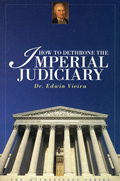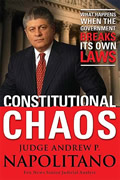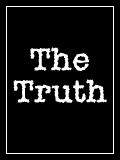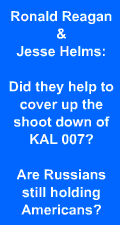Other
Vieira
Articles:
Are Monetary & Banking Crises Inevitable in the Near Future?
"Homeland Security" -- For What and For Whom?
THE
STATE ELECTRONIC GOLD CURRENCY PLAN
PART 1
Dr.
Edwin Vieira, Jr., Ph.D., J.D.
April 20, 2005
NewsWithViews.com
Two of my earlier commentaries--DON'T COUNT ON WASHINGTON TO PROTECT US FROM A LOOMING BANKING CRISIS and CAN AMERICANS SOLVE THEIR MONETARY AND BANKING PROBLEMS FOR THEMSELVES?--have explored why this country cannot expect either the General Government or Americans as isolated individuals to solve the monetary and banking problems the Establishment has caused. Rather, America needs to find a workable mechanism that can
-
return a significant part of this country to sound money and honest banking whether or not a monetary crisis ever occurs, before a crisis breaks out, and surely in case a crisis flares up;
-
educate Americans--economically, politically, and in particular constitutionally--about the use of gold and silver as media of exchange;
-
encourage, empower, and enable Americans to use gold, silver, or both as their preferred media of exchange;
-
provide a nonpolitical--that is, private, free-market--medium of exchange actually consisting of (not just "backed" by) gold, silver, or both, but that government at every level can use for all public purposes, too;
-
create open competition in both private commerce and public finance between gold and silver commodity moneys, on the one side, and fiat Federal Reserve Notes and base-metallic coinage, on the other; and
-
offer an alternative to fractional-reserve banking.
For genuine and lasting monetary and banking reform to occur:
(1) This mechanism must be capable of operating and expanding in anticipation of, in response to, and during any regional, national, or international monetary and banking crisis, in order to solve or moderate, if not prevent or mitigate the worst effects of, the crisis in at least the location where the mechanism is already functioning. This capability is necessary to obviate any supposed need for �emergency� legislation or other draconian devices in that locale, so that the mechanism can prove itself there and thus serve as a model for the protection or rehabilitation of the remainder of the country.
(2) This mechanism needs to be put into operation well before a crisis breaks out--indeed, the sooner the better. Which means that it must be capable, both economically and politically, of being implemented in some significant place in the foreseeable future.
(3) Although this mechanism must be capable of beginning to function immediately upon adoption, it should be introduced, not on a "crash" basis, but as a measured, gradual reform that can be carefully thought through, publicized, put into place, tested, and perfected while everyone is still thinking clearly and acting calmly. It must be a mechanism that everyone will come to know is available, that many people will actually use even in the absence of any crisis, and that through such use will come to be widely understood and trusted.
(4) This mechanism must be economically viable from its very onset. If an even theoretically sound plan for monetary and banking reform proves too complex, cumbersome, or costly to implement in its initial stages, what will be necessary to avert or address a crisis will not be accomplished in time.
(5) This mechanism must be capable of interacting efficiently at all times with the present monetary and banking systems, yet nevertheless operate outside and independent of, and (most importantly of all) not suffer from any of the major problems that beset, those systems. Thus, it must be based on private, parallel, and competitive currency that consists of actual gold or silver, not mere claims thereto--let alone a new fiat currency. The depositary institutions that provide this new specie currency must operate on the principle of "bailment"--whereby the depositaries hold their customers' gold or silver not as the depositaries' property, to which the depositors have only a claim for the payment of a debt, but as the depositors' property, in which the depositaries can assert no proprietary interest whatsoever. Consequently, the depositaries cannot engage in the pernicious practice of "fractional reserves", or claim the special privilege to "suspend specie payments" (i.e., to assert immunity from their own contractual obligations to their depositors, while nonetheless remaining in business themselves).
(6) This mechanism must be targeted, systematic, and institutionalized, rather than dependent upon the uncoordinated efforts of isolated individuals most of whom will be unaware of, and unable to cooperate with, each others' activities. It must operate both extensively and comprehensively�that is, it must immediately involve a large number of people within a specific geographical area carefully chosen on the basis of its economic and political significance, then extend fully throughout that area, then expand into other areas, and at length embrace the vast majority of citizens throughout the United States. In monetary and banking reform, "small is not necessarily beautiful" and is certainly not likely to be effective, because: (i) no tiny social enclave, no matter how apparently isolated and self-sufficient, will prove completely immune from the adverse effects of a nationwide or worldwide monetary and banking collapse; (ii) no such enclave's partial success in protecting itself is likely to have significant positive spill-over effects elsewhere; and (iii) no such success in some isolated enclave can provide a convincing test of the method's usefulness in larger areas with more complex economies. (Although, of course, if such is the best that can be done, then the inhabitants of every out-of-the-way enclave should do it, and let the rest of the country stew in its own juices.)
(7) For these reasons, this mechanism must be introduced in a locale that, in terms of geographical area, population, and level of economic activity, is relatively large and complex, rather than small and simple. Also, it must initially operate through a major participant in the market--that is, one with which large numbers of people financially interact, directly or indirectly, on a regular and permanent basis, and which continually takes in and pays out significant amounts of purchasing power in whatever currencies it employs.
(8) This mechanism will need a large degree of legal immunity from interference by the General Government (especially the Department of the Treasury) and the Federal Reserve System, which will undoubtedly claim "supremacy", "exclusive jurisdiction", and powers of "preemption" as to any new currency. For the very creation, let alone the operation and success, of any mechanism for monetary and banking reform will inevitably subject it to retaliation from the Establishment, fanatically opposed as it is to remonetization of gold and silver.
(9) Finally, operation of this mechanism must not be likely to trigger a depression, hyperinflation, or other monetary and banking crisis when it starts the open competition between gold and silver, on the one side, and fiat currency, on the other. After all, the purpose of reform is not to bring down the Federal Reserve System, come Hell or high water, but to replace it with sound money and honest banking in as timely, orderly, and inexpensive a manner as possible. Prudence must be the watchword.
The foregoing criteria for a successful reform compel the following conclusions:
I.
The new medium of exchange should be a private electronic specie currency
unit, itself of gold or silver, and fully convertible into standard
gold or silver coins or bars. At the present time, the best choice
available in the free market is the "goldgram", provided by James
Turk's GoldMoney (at
The "goldgram" is a fixed weight of actual gold, but divisible electronically into very small amounts (0.001 part of a "goldgram", or a "mil"), so that transactions of almost any size can be easily and expeditiously carried out.
The "goldgram" is transferrable anywhere over the Internet, making it a truly global currency. But, being entirely private in origin and operation, it is immune from the systematic political manipulations that commonly affect currencies emitted by governmental treasuries or central banks.
Because it is a completely private currency, the "goldgram" is protected by better safeguards than either the Treasury's coins or the Federal Reserve System's notes can claim. First, the "goldgram" is a fixed unit of weight of pure gold, with no arbitrary "dollar" denomination. This is quite distinguishable from the Treasury's gold, silver, and base-metallic coins that are all denominated in numbers of "dollars" which are not only largely fanciful in constitutional terms, but also exhibit no rational relationship among themselves in the economic terms of their various purchasing powers in the free market.
Second, a holder of "goldgrams" owns a fixed amount of gold, itself a valuable commodity; whereas the holder of Federal Reserve Notes owns nothing but the Notes themselves, at best a political debt. True, a holder of Federal Reserve Notes has a legal right to their redemption "in lawful money". Title 12, United States Code, Section 411. But no statute mandates the redemption of Federal Reserve Notes "in lawful money" containing any permanently fixed amount of any specific commodity. At best, a holder of those notes is entitled only to their face value in United States base-metallic coins, which can contain whatever slivers of junkyard scrap Congress and the Treasury decide to stamp as "money" from time to time--and which specifically at this time cannot include either gold or silver. See Title 31, United States Code, Section 5118(b) and (c).
Third, because each "goldgram" is the depositor's own private property--not a debt owed to him by GoldMoney--the electronic gold currency system avoids all the problems of Ponzification inherent in fractional-reserve banks.
Yet, although they are held and transferred outside the established banking system, "goldgrams" are freely exchangeable with Federal Reserve Notes and base-metallic coinage, and vice versa. This provides users of "goldgrams" with outstanding protection, flexibility, convenience, and efficiency for all their monetary transactions. "Goldgrams" can function as a truly parallel currency, because any contract can be made, and paid, in "goldgrams" or fiat currency, as suits the parties' needs.
The widespread introduction and use of "goldgrams" in America's economy can cause neither a depression nor an hyperinflation, either. A depression will not occur, because extensive use of "goldgrams" will actually increase the supply of true, commodity money by remonetizing gold (and silver, too, when an equivalent system for "digitizing" that metal appears). So, even to the extent that "goldgrams" may displace Federal Reserve Notes and base-metallic currency from use, the economy will suffer no destabilization. A more sound currency will simply supplant a less sound currency, by operation of the free market. No hyperinflation will occur, either, because the supply of monetary gold is incapable of huge, arbitrary, and especially politically driven increases. Rather, it is fixed by physical availability, and the free market's control over its production. Conceivably, Federal Reserve Notes and base-metallic currencies may depreciate against gold; but, as they do, gold will appreciate against them.
Of great importance, too, is that "goldgrams" are freely convertible into standard gold and silver coins and bullion as part of GoldMoney's normal operations. This qualifies "goldgrams" for use in all public functions by States and localities that must satisfy the requirement of Article I, Section 10, Clause 1 of the Constitution that "[n]o State shall * * * make any Thing but gold and silver Coin a Tender in Payment of Debts". In selecting "goldgrams" as her medium of exchange, a State is not "coin[ing] Money" (which that Clause prohibits her from doing), merely employing a private gold currency over which she has no control. Neither is the State "emit[ting] Bills of Credit" (which that Clause also prohibits her from doing), because "goldgrams" are not anyone's "Bills of Credit" that only promise to pay, but actual gold that is the very stuff of payment. And when the State offers "goldgrams" "in Payment of [her] Debts", she "Tender[s]" such "gold and silver Coin" as her creditors may desire to receive by automatic conversion of their "goldgrams" into coinage--so that the creditors, not the State, fix what shall be the form of the gold (or silver) that functions as the final "Tender" for the transactions.
II.
The last point is crucial, because the major participant in the market
through which monetary and banking reform initially must operate most
likely will be a State. Indeed, reliance on a State is probably the
indispensable key to reform, as PART TWO of this commentary will disclose.
� 2005 Edwin Vieira, Jr.
- All Rights Reserved
Edwin Vieira, Jr., holds four degrees from Harvard: A.B. (Harvard College), A.M. and Ph.D. (Harvard Graduate School of Arts and Sciences), and J.D. (Harvard Law School).
For more than thirty years he has practiced law, with emphasis on constitutional issues. In the Supreme Court of the United States he successfully argued or briefed the cases leading to the landmark decisions Abood v. Detroit Board of Education, Chicago Teachers Union v. Hudson, and Communications Workers of America v. Beck, which established constitutional and statutory limitations on the uses to which labor unions, in both the private and the public sectors, may apply fees extracted from nonunion workers as a condition of their employment.
He has written numerous monographs and articles in scholarly journals, and lectured throughout the county. His most recent work on money and banking is the two-volume Pieces of Eight: The Monetary Powers and Disabilities of the United States Constitution (2002), the most comprehensive study in existence of American monetary law and history viewed from a constitutional perspective. www.piecesofeight.us
He is also the co-author (under a nom de plume) of the political novel CRA$HMAKER: A Federal Affaire (2000), a not-so-fictional story of an engineered crash of the Federal Reserve System, and the political upheaval it causes. www.crashmaker.com
His latest book is: "How To Dethrone the Imperial Judiciary"
He can be reached at:
P.O. Box 3634,
Manassas, Virginia 20108.
E-Mail: Coming
soon
The new medium of exchange should be a private electronic specie currency unit, itself of gold or silver, and fully convertible into standard gold or silver coins or bars.














